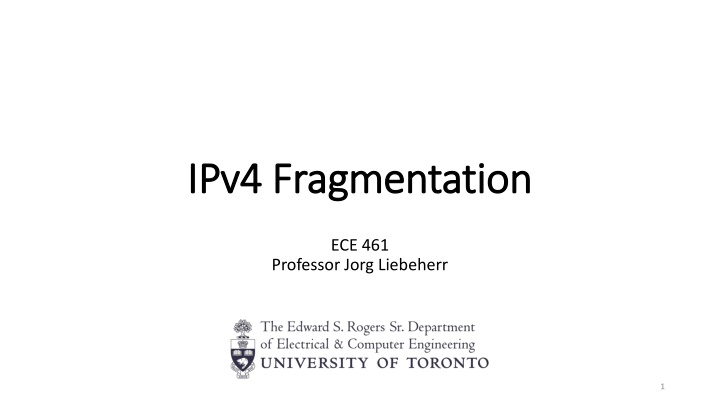
IPv4 Fragmentation and MTU Limits
Explore the concept of IPv4 fragmentation, Maximum Transmission Unit (MTU) constraints, and the process involved in fragmenting and reassembling IP datagrams. Learn how routers and hosts handle fragmentation, and the key fields in the IP header related to this process.
Download Presentation

Please find below an Image/Link to download the presentation.
The content on the website is provided AS IS for your information and personal use only. It may not be sold, licensed, or shared on other websites without obtaining consent from the author. If you encounter any issues during the download, it is possible that the publisher has removed the file from their server.
You are allowed to download the files provided on this website for personal or commercial use, subject to the condition that they are used lawfully. All files are the property of their respective owners.
The content on the website is provided AS IS for your information and personal use only. It may not be sold, licensed, or shared on other websites without obtaining consent from the author.
E N D
Presentation Transcript
IPv4 Fragmentation IPv4 Fragmentation ECE 461 Professor Jorg Liebeherr 1
Takeaways Takeaways Understand the steps of fragmentation in IPv4 2
Maximum transmission unit (MTU) Maximum transmission unit (MTU) Maximum size of IP datagram is 65535, but the data link layer protocol generally imposes a limit that is much smaller Example: Ethernet frames have a maximum payload of 1500 bytes IP datagrams encapsulated in Ethernet frame cannot be longer than 1500 byte The limit on the maximum IP datagram size, imposed by the data link protocol is called maximum transmission unit (MTU) Ethernet 1500 MTUs for various data link protocols (in bytes): 802.3 1492 WiFi 2304 (mostly set to: 1500) Minimum required 572 3
IP fragmentation IP fragmentation What if the size of an IP datagram exceeds the MTU? IP datagram is fragmented into smaller units What if the route contains networks with different MTUs? Fragments of an IP datagram may get fragmented again Router Host A Host B MTU: 2000 MTU: 1000 Fragmentation: IP router splits the datagram into several datagram Fragments are reassembled at receiver 4
Where is fragmentation done? Where is fragmentation done? Fragmentation can be done at the sender or at routers The same datagram can be fragmented several times Reassembly of original datagram is only done at destination hosts !! IP datagram H Fragment 2 H2 Fragment 1 H1 Router 5
What i What is involved in fragmentation? s involved in fragmentation? The following fields in the IP header are involved: header length total length (in bytes) ECN DS version D F M F Identification Fragment offset 0 time-to-live (TTL) protocol header checksum Identification unique identification of a datagram from a host. Incremented whenever a datagram is transmitted. When a datagram is fragmented, the identification is the same in all fragments DF bit (Do not fragment): If set, datagram cannot be fragmented and must be discarded if MTU is too small MF bit (More fragments): If set, this datagram is a fragment and at least one additional fragment follows this one Flags 6
What i What is involved in fragmentation? s involved in fragmentation? header length total length (in bytes) ECN DS version D F M F Identification Fragment offset 0 time-to-live (TTL) protocol header checksum Fragment offset 1/8th of the offset of the payload of the current fragment in the original datagram The fragment offset has only 13 bits The total length has 16 bits The actual offset in bytes is the value of the offset field multiplied by 8 Total length Total length of the current datagram 7
Example of fragmentation Example of fragmentation A datagram with size 2400 bytes must be fragmented according to an MTU limit of 1000 bytes Header length: Total length: Identification: 20 Header length: Total length: Identification: 20 448 Header length: Total length: Identification: 20 996 Header length: Total length: Identification: 20 996 2400 0xa428 0xa428 0xa428 0xa428 DF flag: MF flag: 0 0 DF flag: MF flag: 0 0 DF flag: MF flag: 0 1 DF flag: MF flag: 0 1 Fragment offset: 0 Fragment offset: 244 Fragment offset: 122 fragment offset: 0 IP datagram Fragment 3 Fragment 2 Fragment 1 MTU: 4000 MTU: 1000 Router 8
Determining the length of fragments Determining the length of fragments Recall that, since there are only 13 bits available for the fragment offset, the offset is given as a multiple of eight bytes. As a result, the first and second fragment have a size of 996 bytes (and not 1000 bytes). This number is chosen since 976 is the largest number smaller than 1000 20= 980 that is divisible by eight. The payload for the first and second fragments is 976 bytes long, with bytes 0 through 975 of the original IP payload in the first fragment, and bytes 976 through 1951 in the second fragment. The payload of the third fragment has the remaining 428 bytes, from byte 1952 through 2379. With these considerations, we can determine the values of the fragment offset, which are 0, 976 / 8 = 122, and 1952 / 8 = 244, respectively, for the first, second and third fragment. 9
Drawback of IP Fragmentation Drawback of IP Fragmentation Fragmentation incurs processing overhead at intermediate routers Performance penalty can be a factor of 10-1000 Some devices (e.g., firewalls) inspect headers of the transport protocol (e.g., port numbers) With fragmentation, only the first fragment of the original datagram has this header Receiver has to reassemble the packets IP module at receiver must store fragments until original datagram is reconstructed This incurs processing overhead If some fragments are dropped in the network, receiver cannot reconstruct the original datagram 10
